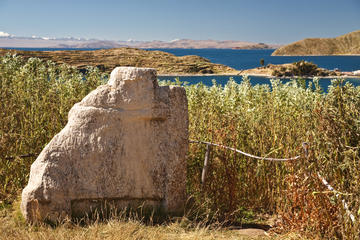
Sun Island (Isla del Sol)
The most important island on the lake, according to pre-Columbian tradition, is the Isla del Sol, “Sun Island.” It is the largest of the lake islands (14.3 square kilometers, or 5.5 square miles), and considered sacred to the Andean Sun God and Inca patron deity, Inti. Today, its dramatically sculpted terrain is home to some 800 families, 180 pre-Columbian ruins, and several kilometers of ancient trails to explore.
It is said that after a great flood cleansed the Earth, Viracocha, the god of creation, rose from the sacred lake and came to this island. First, he created Inti, the sun, and Mama Quila, the moon. Two large “footprints” in the stone, still visible on the path to the sacred city of Challapampa, mark the spot where Viracocha created the Earth’s first man and woman, Mallco Capac and Mama Ocllo.
While it’s possible to come here on a day trip from Copacabana (but not Puno; Isla del Sol is on the Bolivian side of Lake Titicaca), it is much better to stay overnight. Most services are in Yumani, also home to an ancient stone fountain that sits atop 206 stone steps; this may be the Fountain of Youth. Boat tours and stone trails lead to scores more ruins, such as the Inca seminary and enormous stone labyrinth called the Chinkana, the ornate Temple of Pilcocaina, and the “Stone Puma,” or “Titi Karka,” thought to have bequeathed upon this lake its name. Sunset is fittingly spectacular, and perhaps best appreciated from the lighthouse, atop the island’s highest point (4,097m/13,441ft).
Nearby Isla de la Luna (Island of the Moon) is another sacred isle, which can be visited by boat tour from either Isla del Sol or Copacabana. The most famous ruins are those of what is thought to have been an ancient convent, called Ajlla Wasi (House of the Chosen Women).
Stories of a nearby lost city, long thought to have been as apocryphal as Plato’s tales of Atlantis, were proven absolutely true in 2000. An international expedition discovered a submerged temple dating to perhaps 700AD, roughly the size of a football field, connected to Copacabana by an undersea road. You can see some of the artifacts uncovered there at the island’s Museo de Oro (Museum of Gold).
